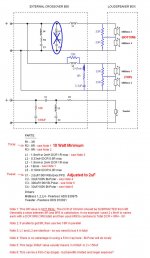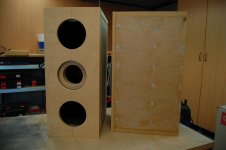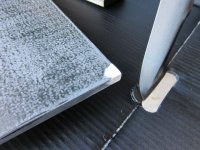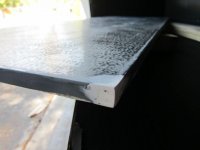Check out post 596 by Renron in the Thor tread. 64799-clarity-seas-thor-kit-60.html As you can see it is only a slight taper. I can't see it making much of a difference, though I could be wrong. The cabinet is much more pleasing to me. Actually, I'm really torn between these two systems, Elsinore,Thor
Have a hard time finding all components here in Europe. Have found this site 830875 - Peerless HDS-164NOMEX Nomex diaphragm, 33 mm coil, AL - Europe Audio that looks promising, anyone with experience?
Due to limited selections here & to the ones that have experimented with different types for this crossover - suggestions:
R1 – 3R :
R2 – 6R8 :
R3 – 9R (or 2 x18) :
R10 – 10R :
L1/L3– 2mH DCR 1Rmax :
L2 – 0,33mH DCR 0R5max :
L4 – 18mH DCR 1R6 (or adjust R2) :
C1 – 2,0uF/100V Rifa Evox PPs :
C2 – 33uF/100V Bi-Polar :
C3 – 300uF/100V (3x100) Bi-Polar :
C4 – 33uF/100V Bi-Polar (or Film) :
C5 – 0,68uF ??? :
Slowly slowly getting closer to a project . . . .
Due to limited selections here & to the ones that have experimented with different types for this crossover - suggestions:
R1 – 3R :
R2 – 6R8 :
R3 – 9R (or 2 x18) :
R10 – 10R :
L1/L3– 2mH DCR 1Rmax :
L2 – 0,33mH DCR 0R5max :
L4 – 18mH DCR 1R6 (or adjust R2) :
C1 – 2,0uF/100V Rifa Evox PPs :
C2 – 33uF/100V Bi-Polar :
C3 – 300uF/100V (3x100) Bi-Polar :
C4 – 33uF/100V Bi-Polar (or Film) :
C5 – 0,68uF ??? :
Slowly slowly getting closer to a project . . . .
Check out post 596 by Renron in the Thor tread. 64799-clarity-seas-thor-kit-60.html As you can see it is only a slight taper. I can't see it making much of a difference, though I could be wrong. The cabinet is much more pleasing to me. Actually, I'm really torn between these two systems, Elsinore,Thor
Ah! I see. The curve is at the back. I was not sure where you were going up until that point.
That indeed may be a horse of a different color. While one would suspect there would be little change needed as long as the volume is maintained, I fear I may be too far out of my league to properly answer your question.
I apologize and hope someone with the appropriate experience chimes in.
Have a hard time finding all components here in Europe. Have found this site 830875 - Peerless HDS-164NOMEX Nomex diaphragm, 33 mm coil, AL - Europe Audio that looks promising, anyone with experience?
Due to limited selections here & to the ones that have experimented with different types for this crossover - suggestions:
R1 – 3R :
R2 – 6R8 :
R3 – 9R (or 2 x18) :
R10 – 10R :
L1/L3– 2mH DCR 1Rmax :
L2 – 0,33mH DCR 0R5max :
L4 – 18mH DCR 1R6 (or adjust R2) :
C1 – 2,0uF/100V Rifa Evox PPs :
C2 – 33uF/100V Bi-Polar :
C3 – 300uF/100V (3x100) Bi-Polar :
C4 – 33uF/100V Bi-Polar (or Film) :
C5 – 0,68uF ??? :
Slowly slowly getting closer to a project . . . .
Is there a question, other than buyer experience with your proposed source, or is this just a general update?
Is there a question, other than buyer experience with your proposed source, or is this just a general update?
It´s actually a question about quality and choice of material. Sorry for being so unclear. This is what I have found in this thread so far but like to have more input if possible:
______________________________________________
R1 – 3R : High Qulity
R2 – 6R8 :
R3 – 9R (or 2 x18) :
R10 – 10R :
L1 – 2mH DCR 1Rmax : High Qulity 14ga foil inductors
L2 – 0,33mH DCR 0R5max : High Qulity 14ga foil inductors
L3 – 2mH DCR 1Rmax :
L4 – 18mH DCR 1R6 (or adjust R2) : iron core
L5 – 0,18mH DCR 0R3mx
C1 – 2,0uF/100V Rifa Evox PPs : High Qulity , Jantzen Audio Superior Z-Cap. Sonicap 2.0uf, 200V lboth with great base sound
C2 – 33uF/100V Bi-Polar :
C3 – 300uF/100V (3x100) Bi-Polar :
C4 – 33uF/100V Bi-Polar (or Film) :
C5 – 0,68uF ??? :
#750~. The largest inductor I use 2 x 9mH in series, these do not have to be air cored, but the rest should be. Cheers, Joe R.
______________________________________________
But there might be more that I have missed.
I've read the entire thread and remember someone asking about a set of curved cabinets, but don't remember if their was an answer. I too would like to build a set with curved sides. I know the cabinet was designed for ease of build, but woodworking is my hobby, so I'm willing to tackle this. I would build it deeper to compensate for the loss of volume. I don't for see a need to adjust the crossover for this, but I could be wrong. Any ideas on this?
Hi.
Have seen this question come up in a number of other builds that i'm looking at. If you are keeping the same baffle and maintaining speaker volume then no change is required.
I think the critical dimensions that need to be maintained are the baffle width and the driver spacing. Possibly also relative position to the top of the baffle (?) but that is getting into details you'd want the designer or other expert to comment on.
hope that helps.
PS - nice build you linked to.
Lewis
Did some more work on the hamlets today.
How are the hamlets progressing?
Have you seen a box with waveguides yet?
Parallel networks relative to the Voice Coils are avoided in the latest Elsinore Mk5 design.
...
So this means that a different set of compromises are being imposed that would otherwise be the case.
...
What is clear is that, if the speaker is pointed directly towards the listener (both of them of course) then expect there to be an excess of energy centered around 4KHz. Toeing out will lessen that lift and if you wish to experiment with that, it is definitely suggested that you do. The final amount of toe-in could well dependent of the inherent brightness of your system and if it is biased that way tonally, you may even find point the speaker straight down the line of the room (but no more) as preferable. But I suggest that in a well-balanced system there will always be some toe-in.
tpate was troubled by this excess energy and after we measured his Mark 5, I modeled the crossover and suggested the attached modification for his crossover. For builders that find their listening setup to highlight the excess woofer energy around 4kHz, this modification might prove to be beneficial.
tpate is currently using this modification and has been very pleased with the results in his setup with both solid state and tube amplifiers.
Basically the modification involves 3 changes shown in blue in the attachment:
1) addition of 4kHz LCR notch filter to the upper woofers, similar but not identical to what was used in the Mark 4 crossover.
- parts involved are 10ohm(10W) placed across L2, and the LCR notch filter made up of 0.47mH + 3.3uF + 8ohm(10W)
2) removal of the LCR midrange impedance compensation from the woofer circuit to avoid an impedance dip in the midrange with two LCR filters in place.
- parts removed are L5, R3, & C4
3) addition of resistors across each woofer to swamp variations in impedance that can result if you receive woofers from different production batches.
- parts involved are 33ohm(10W) resistors placed across the voice coil of each woofer.
Attachments
How are the hamlets progressing?
Have you seen a box with waveguides yet?[/QUOTE
they haven,t turned up yet unfortunatly but once the arrive won,t take long to finish them off.
I,ll keep you posted.
I do have a question for Joe, what diameter do you want me to make the port hole.

I have been listening to Bolserst's crossover mod for a few months now. If you are running a linear current amp the mod might not be for you. If you are running a conventional tube or transistor a or ab amp I would highly suggest you try it. First go with the 33 ohm resistors in parallel with the woofers. The bass gets really tight and the midrange is more defined. The notch filter smoothes the top end and both of my amps "liked" the load better than stock. I say this because the music seems to flow more easily, dynamics are better and the image is rock solid. I also use the "gap" on the wave guide with these mods. Before the mods I listened to my hybrid tube/transistor amp 80% of the time, the tube amp just couldn't keep up. Now I listen to each amp an equal amount. Never heard a tube system sound so good, and this is using a pentode. The sound now rivals my 20K list price Soundlab A-1's, for listenability and image. I didn't say anything earlier since it was Bolserst's mod and we wanted to make sure that the mod stood the test of time. (Sometimes mod's sound different and it takes time and many different albums to make sure they sound better.)
I have been listening to Bolserst's crossover mod for a few months now. If you are running a linear current amp the mod might not be for you. If you are running a conventional tube or transistor a or ab amp I would highly suggest you try it. First go with the 33 ohm resistors in parallel with the woofers. The bass gets really tight and the midrange is more defined. The notch filter smoothes the top end and both of my amps "liked" the load better than stock. I say this because the music seems to flow more easily, dynamics are better and the image is rock solid. I also use the "gap" on the wave guide with these mods. Before the mods I listened to my hybrid tube/transistor amp 80% of the time, the tube amp just couldn't keep up. Now I listen to each amp an equal amount. Never heard a tube system sound so good, and this is using a pentode. The sound now rivals my 20K list price Soundlab A-1's, for listenability and image. I didn't say anything earlier since it was Bolserst's mod and we wanted to make sure that the mod stood the test of time. (Sometimes mod's sound different and it takes time and many different albums to make sure they sound better.)
I've been running the changes for a few months as well. I have the same experience as tpate with the tube amps. Switching between SS and 8w 300b amps and leaving the tubes in for much longer periods..
It´s actually a question about quality and choice of material. Sorry for being so unclear. This is what I have found in this thread so far but like to have more input if possible:
______________________________________________
R1 – 3R : High Qulity
R2 – 6R8 :
R3 – 9R (or 2 x18) :
R10 – 10R :
L1 – 2mH DCR 1Rmax : High Qulity 14ga foil inductors
L2 – 0,33mH DCR 0R5max : High Qulity 14ga foil inductors
L3 – 2mH DCR 1Rmax :
L4 – 18mH DCR 1R6 (or adjust R2) : iron core
L5 – 0,18mH DCR 0R3mx
C1 – 2,0uF/100V Rifa Evox PPs : High Qulity , Jantzen Audio Superior Z-Cap. Sonicap 2.0uf, 200V lboth with great base sound
C2 – 33uF/100V Bi-Polar :
C3 – 300uF/100V (3x100) Bi-Polar :
C4 – 33uF/100V Bi-Polar (or Film) :
C5 – 0,68uF ??? :
#750~. The largest inductor I use 2 x 9mH in series, these do not have to be air cored, but the rest should be. Cheers, Joe R.
______________________________________________
But there might be more that I have missed.
I'm super interested in people who have built a set of Elsinore's choice of capacitors, inductors and resistors too.
I found this great reference: Humble Homemade Hifi which deals with the characteristics of capacitors, but havnt found much on the others apart from what Sharkythefrog has summerised above.
Small setback, nothing that cannot be fixed though...
No, I have not dropped off the planet. Spent the holidays applying layers of finish. The side panels have taken far longer to get the look I am after.
So, I finally got everything done and was going to start final assembly of the side panels to the main cabinets when an accident happened. I should have known better as I was just getting over a stomach flu that had literally kicked my a--.
During the prep for glueing, I was not paying attention and the panel, precariously perched on my work table, slid off and careened into the floor. The resulting force mashed in one of the corners. Now, there are only four corners and only one is the top front corner, the corner most visible, the only corner that MUST be perfect. Guess which corner hit the floor first? Yup, you guessed right.
So, I ended up using J-B Weld wood epoxy to rebuild the corner. It worked really well. Very easy to work with and took only two coats to blend correctly and shape to match the seam correctly. I am now in the middle of sanding, repainting and refinishing that piece. Hopefully it will look close enough to the other pieces, which I had painstakingly worked to be identical. Crossing my fingers.
The day job is backing my up big time, but, hopefully within the next week or two I can finish the cabinets once and for all.
No, I have not dropped off the planet. Spent the holidays applying layers of finish. The side panels have taken far longer to get the look I am after.
So, I finally got everything done and was going to start final assembly of the side panels to the main cabinets when an accident happened. I should have known better as I was just getting over a stomach flu that had literally kicked my a--.
During the prep for glueing, I was not paying attention and the panel, precariously perched on my work table, slid off and careened into the floor. The resulting force mashed in one of the corners. Now, there are only four corners and only one is the top front corner, the corner most visible, the only corner that MUST be perfect. Guess which corner hit the floor first? Yup, you guessed right.
So, I ended up using J-B Weld wood epoxy to rebuild the corner. It worked really well. Very easy to work with and took only two coats to blend correctly and shape to match the seam correctly. I am now in the middle of sanding, repainting and refinishing that piece. Hopefully it will look close enough to the other pieces, which I had painstakingly worked to be identical. Crossing my fingers.
The day job is backing my up big time, but, hopefully within the next week or two I can finish the cabinets once and for all.
Attachments
Hi guys, I'm looking at starting a new build and considering the Elsinore, and have a couple of what might be straightforward questions:
1. Budget: is ~$1000 feasible, leaving out things like rosewood veneers and whatnot? This is assuming I build everything and without egregious corner-cutting, maybe economizing a little in places that could be upgraded later on when I feel like burning more $.
2. Waveguide: Does it have to be a metal like aluminum? I have a small CNC mill that can do feature sizes up to ~3" in size, above that I need to start re-fixturing it which gets trickier. As best as I can tell, the largest feature on the WG is ~4". If I could do wood or MDF, I have easy access to a larger router table.
2b. Waveguide: What are the tolerances on this? If I do a circular feature on my mill it will come out slightly oval-shaped. E.g. a 1" circle will be maybe 1.004 wide by .996 high. Would this be fatal or could it be adjusted for when the waveguides are mounted?
2c. Waveguide: How "smooth" does the surface of the conical part need to be? I'm just envisioning milling this out and off the mill it will generally have a slightly "stepped" or scalloped finish, and to get better you either have to spend exponentially more time milling or hit it with sandpaper/vibratory finish/sandblast. Or even put some filler like Bondo on and sand that. Just wondering if it needs to be glass flat or if very small variations are OK.
Thanks in advance!
1. Budget: is ~$1000 feasible, leaving out things like rosewood veneers and whatnot? This is assuming I build everything and without egregious corner-cutting, maybe economizing a little in places that could be upgraded later on when I feel like burning more $.
2. Waveguide: Does it have to be a metal like aluminum? I have a small CNC mill that can do feature sizes up to ~3" in size, above that I need to start re-fixturing it which gets trickier. As best as I can tell, the largest feature on the WG is ~4". If I could do wood or MDF, I have easy access to a larger router table.
2b. Waveguide: What are the tolerances on this? If I do a circular feature on my mill it will come out slightly oval-shaped. E.g. a 1" circle will be maybe 1.004 wide by .996 high. Would this be fatal or could it be adjusted for when the waveguides are mounted?
2c. Waveguide: How "smooth" does the surface of the conical part need to be? I'm just envisioning milling this out and off the mill it will generally have a slightly "stepped" or scalloped finish, and to get better you either have to spend exponentially more time milling or hit it with sandpaper/vibratory finish/sandblast. Or even put some filler like Bondo on and sand that. Just wondering if it needs to be glass flat or if very small variations are OK.
Thanks in advance!
Hamlets
As per Joes post 80 on page 8.
Re port, use 60mm (internal) and 120mm long. If the 60mm port is slightly less than 60mm, then that will be OK as well. But if it gets close to 55mm, then reduce length to 100mm.
I found this.
OD: 90mm
ID: 60mm
L: 125mm
Cutout: 70mm
Looks the goods.
As per Joes post 80 on page 8.
Re port, use 60mm (internal) and 120mm long. If the 60mm port is slightly less than 60mm, then that will be OK as well. But if it gets close to 55mm, then reduce length to 100mm.
I found this.
OD: 90mm
ID: 60mm
L: 125mm
Cutout: 70mm
An externally hosted image should be here but it was not working when we last tested it.
Looks the goods.
- Home
- Loudspeakers
- Multi-Way
- The "Elsinore Project" Thread



